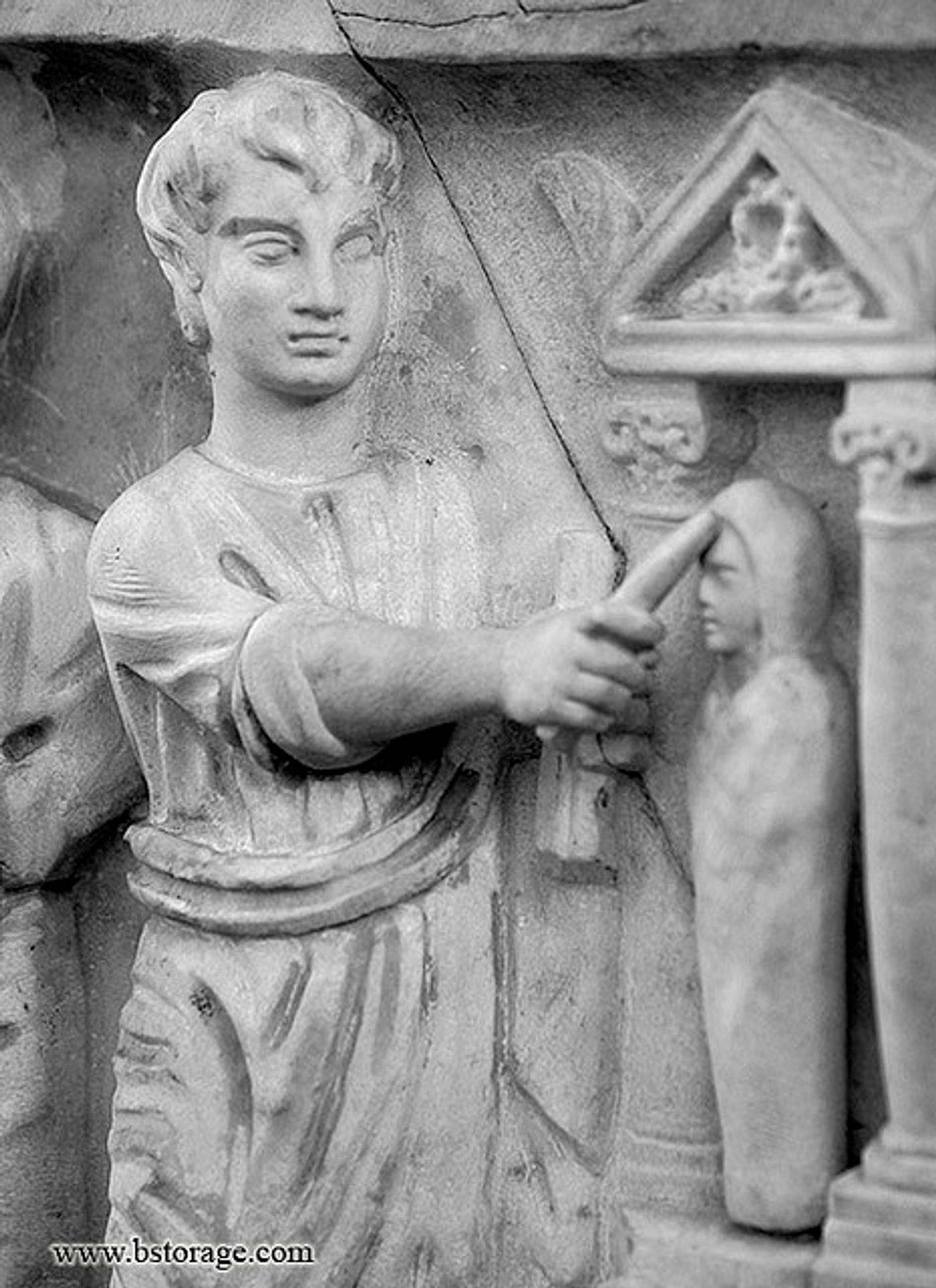

The Powwow Guy
Home of Robert Phoenix and Traditional Christian Pennsylvania German Powwow
Weather prediction

A weather charm I learned many years ago.
Thrust your knife into the ground with the blade facing the oncoming weather.
"Three angels ride the winds
to lands both far and near
Go west, go east, go south, go north
but do not linger here!"
Leave the blade in place until the weather has passed.
Weather signs and portents
Predicting the weather has long been an understood part of being a farmer or gardener. All of my life I've heard predictive bits of information from the people around me. I remember my grandfather always knew rain was coming because his back would hurt. Now, being a middle-aged man myself, I have that unfortunate ability!! Another way I can tell the weather is my ears swell shut. I have complex hearing issues and when my hearing aids prove useless, it means humid air and thunderstorms. See how powerful old age can be! :)
Weather prediction is fascinating to me. It's not fool-proof, but it's very interesting and accurate enough to get you through your day. If you are right with your predictions, then you can feel satisfied that you planned accordingly. If you are wrong, well, it happens to the best of us.
The following bits of predictive folklore are by no means "scientific", nor are they the only method of predicting the weather. However, I present them here as a matter of folkloric interest. I still adhere to most of these. If you know more, PLEASE send them to me!
When the full moon has a halo around it, rain is expected.
If the crescent moon has horns pointing down, rain is coming.
If the cows are laying in the fields, expect rain.
If the leaves on the trees are flipped over, grab your umbrella.
If you dog is eating grass on his morning walk, expect rain that afternoon.
If your cat is laying with the top of his head against the floor, rain is on the way.
When the smoke from the chimney goes down instead of up, rain or snow is forecasted.
Arthritic joints become inflamed and achy when barometric pressure changes, meaning rain.
If rice is spilled on the kitchen floor, expect rain.
The faster the crickets chirp, the hotter the weather will be.
If the sky is red in the morning, it will be a rainy afternoon.
If rain is falling when you first wake up, it will likely continue until noon.
A knife stuck in the ground will weaken an oncoming storm.
When the temperature decreases before noon, rain is likely to fall all day long.
When the ants stop working, rain is coming.
When the fish go into hiding, a hot sunny day is in the forecast.
A clear moon on a winter night predicts frost the next morning.
When pine cones are closed up, it means rain. When open, it means dry and sunny weather.
When your fire burns blue, a storm approaches.
Many crows gathered in one place portends a storm.
If the birds are up high in the trees, it means good weather. If they are on the low branches, it means rain.
Look for continued fair weather when:
A gentle wind blows from the west, northwest, or a little south of west.
The sun sets in a cloudless sky.
The sunset is composed of light tints, inclining to red or yellow.
The sunset is followed by a glowing and slow. fading western sky.
The sun sets like a ball of fire (warmer).
The sun rises out of a gray sky.
The clouds are noticeably high for the season.
The clouds rise on the mountains.
The clouds have frequent breaks showing blue sky between.
The puffy cumulus clouds show a lot of white.
The cumulus clouds decrease toward nightfall.
The winter sky is mottled with a northwest wind.
The summer morning fog breaks before ten o'clock.
The dawn is low.
The blue sky has a tendency to show green near the northern horizon (colder).
The sun breaks through a departing thunderstorm and makes a rainbow.
Snow-flurries drift down a north wind (colder).
Cirrus clouds, or others, dissolve, or cirrus have tails down.
Spiders spin on the grass.
There is a moderate dew or frost.
The temperature is normal or colder than normal, other signs being right.
The sky is sown with stars.
The moon rises clear.
The wind blows down mountain ravines after nightfall.
The salt is dry, smoke ascends, birds fly high, and animals act normally.
The barometer rises slowly, or is steady at or above 30.00.
No change need be feared as the anticyclone nears, or for three days after clear conditions are established so long as the wind remains brisk from some westerly quarter. The direction of the wind, the kind of cloud, and the temperature changes are the factors to watch if you have no barometer.
Look for a change toward storms when:
The west wind suddenly drops.
The west wind shifts to south or northeast.
The cirrus clouds appear in well-organized lines.
The cirrus clouds merge into cirro-stratus.
The sky looks like fish scales, so-called mackerel sky.
Light scud drifts across the sky from east to west.
The summer cumulus clouds increase in size as the afternoon proceeds.
Walls grow damp, flies are more of a burden than usual, swallows fly low.
Smoke falls to the ground.
There have been three white frosts.
A halo appears around either the moon or sun.
When sun-dogs appear about the sun, denoting ice-particles in the air.
The summer morning is sultry and the wind variable.
The temperature is much above the normal.
Few stars are visible and those are indistinct.
The clouds gather about the mountain tops, or drop down the mountain-sides.
The wind continues to blow up ravines after nightfall.
The sunset is a dull gray, or the sun sets into a livid cloudbank.
The sunrise is a fiery red, and the dawn is high.
The sun gradually is smothered in fine-textured clouds and the wind shifts.
The temperature does not fall at night.
The signs most to be heeded are the shift of wind to a point east of north or south, the gradual filming of the sky with. cirrus and cirrostratus, and the increase of temperature. Of course, the barometer is the best indicator of all.
Look for a change toward clearing when:
The wind shifts from the easterly quarter into the west.
The temperature falls rapidly.
The clouds rise, or break, or lighten perceptibly in color.
Patches of blue sky appear through the rifts in the clouds, wind north.
Raindrops grow smaller after the windshift.
Snowflakes drive less busily, float lazily down, or thin out conspicuously.
Seams appear in the clouds, snow will cease and rain probably.
The thunder and lightning occur only in the eastern quarter.
Permanent clearing will not be effected until the change of the wind to the points on the western half of the compass show that the cyclone has definitely passed to the north or south or over the locality. In winter the cloud covering may move off slowly, but there will be little precipitation after the wind has reached north or west. The bank of cirro-stratus gets thinner and the moon or the sun gradually shines through. In summer clearing is much more abrupt, as is the clouding up. The ability to sense accurately the moment when the weights are shifted and the change to clearing commences takes some observation to acquire, but the advantage is worth it.
Rain (or snow) will fall:
Within five minutes after the arch of the thundercloud is seen to move toward one.
Within five minutes when the curtain of falling drops obscures the landscape to the west of one.
Within a few minutes after the bottoms of cumulus clouds turn from black to gray, letting down visible trailing showers.
Within a short while after the winter sky has become uniform in color.
Within an hour after the pavement-like, but scarcely discernible, thundercloud consolidates along the west, if the wind is from the southwest. If the wind is from the southeast this cloud may take four hours to rise.
From two to eight hours after the sun or moon has vanished behind the cirro-stratus. From eight to forty-eight hours after the first cirrus is seen, depending upon the distance from the sea and the time of year.
Every little while from southwest showers in the passing of a summer low.
For about eight to twelve hours continuously in a winter storm, and intermittently until the wind swings west.
For a very short while from a thunder cloud rising on a west wind.
For an hour or more from a thundercloud that rises on a southwest or southeast wind.
The temperature will fall when:
A thunderstorm breaks, continuing low if the wind blows from the west after clearing.
Nightfall approaches and the sky is free from clouds.
The mercury remains at the same level during the sunny hours.
A cyclone is departing and the anticyclone moving in.
The wind swings north of east in a storm, -- the fall will be gradual.
The wind swings west of south in a storm, -- the fall will be sudden.
A snowstorm begins, for a short time only.
A cloudy day clears at sunset.
Snow flurries are seen.
The sky shows green and the clouds look hard.
The temperature will rise when:
A thunderstorm is brewing, or a day or two before a winter cyclone.
After a thunderstorm if another is to follow.
The morning is free from clouds and if it is not the first day of a cold wave.
The wind dips south of west or south of northeast, the former shift bringing the more sudden rise.
The sun sets as a ball of fire, at which one can easily look.
A snowstorm gets under way, unless the wind is swinging toward the north.